Level Analysis
Introduction
As the introduction noted, the quantitative aspects of the game—the distance of jumps, the number of intercepts, the HP of enemies—do not consistently increase across the course of the game. After the first world (Yoshi's Island) the growth of the numerical aspects of the game hit a plateau. There are exceptions, obviously, in every level that represents the peak of any element, but these peaks don’t come at the end of the game. For example, the level with the most intercepts is Vanilla Secret 2, smack in the middle of the game. (This assumes you don't count procedurally generated enemies, which you shouldn't, because the player is supposed to bypass those enemies as fast as possible in every level in which they appear. Indeed, that's the whole point of having procedural enemies—to make the player keep moving.) The level with the highest average d-distance is in the second castle level. The level with the greatest number of platforms of less than three blocks in width is Valley of Bowser 3, which is close to the end of the game, but does anyone consider this to be one of the harder levels? There’s a lot of quantitative expansion from the beginning of a level to the end of that same level, but the structure of the whole game itself does not mirror this pattern. Therefore, our goal is to figure out how the skill themes develop qualitative complexity from beginning to end.
There are two ways in which this qualitative increase in difficulty happens: iteration and accumulation. Iteration is the process by which a theme introduces various forms of the same idea. In essence, iteration is about exploring all the possibilities for a single game design theme. Usually, the later iterations are more complex, but it’s not always so, and the difference isn’t drastic. For example, the moving targets theme starts with a platform that stands still until jumped upon--a platform whose movement Mario mostly controls. It ends with a platform that doesn't even carry Mario with it when it moves. Somewhere in the middle it also picks up an irregular path, but none of these challenges are that much harder than the previous form.

Now, when the later stages of the game begin, the designers move out of iteration and into accumulation, in which all of the ideas introduced during iteration are stacked on top of each other (figuratively) in the same few levels. For example, the intercepts theme has introduced several different kinds of intercepts with different kinds of behavior. This challenge in Outrageous contains almost all of them at once!
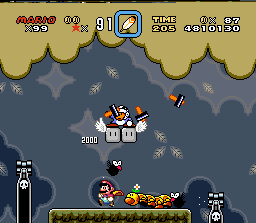
All of the themes in the game eventually proceed from iteration to accumulation, although each one does so in a different way and at a different speed. Included as the headnote to each theme is a summary of how that theme develops through iteration and accumulation, which also serves as a useful introduction to the theme.
Note that this document analyzes every level in the game except Bowser’s Castle and does not examine any of the castle boss fights. Bowser’s Castle is merely a pastiche of level design ideas better examined in other levels. We also did not examine the boss fights. (Also, we’re already done with the Switch Palaces.) Most of the game design in Super Mario World is still relevant to modern games; the bosses are not. The bosses have aged badly. This seems to be a problem many Mario games face—that the boss fights are of a much poorer quality than the rest of the game. The only game with innovative boss fights that really include the game’s mechanics and player skills in a meaningful way is probably Yoshi’s Island, although that is an un-researched opinion.
Also, a last note on our counting methods: we measured every jump event in the game, but not all of them are included in the averages we use here for several reasons. The most obvious exclusion is data from water levels. That data is useful for comparing water-based challenges to other water-based challenges, but there are no discrete jump events, per se. Thus, that data is excluded because of its ambiguity and relative scarcity. The only place where this probably affected the data was in the intercepts theme, because there are a lot of intercepting fish in the sea. There were other, less obvious exclusions. For jump events with a negative delta height, we excluded the delta height statistic. As we stated earlier, jump events with a positive delta height tend to be difficult, while negative delta heights tend to be easy but for the presence of a complicating factor--usually an intercept. As you might expect, the intercepts theme has the greatest number of jump events with a negative delta height, because many of those descending jumps aren’t about the terrain as much as they are about the intercept featured there. But aside from that datum, negative delta heights have little to tell us. Usually a negative delta height without an intercept is simply the designer's way of raising the height of the NEXT jump, or other contrivance that sets up a subsequent event or challenge. Similarly, we have omitted negative delta width as signifying something other than the difficulty of a jump event. A negative delta width typically signifies that Mario is landing on a much larger platform than he left, which usually signifies the end of a challenge. As noted elsewhere, the beginnings and endings of challenges are usually defined by platforms which provide relative safety and ease. These platforms tend to be relatively large in comparison to the rest of the platforms in the level to make this safety palpable. Coming after a smaller platform, this results in the negative delta width which we then exclude, because it’s not telling us anything interesting about challenges in the jump event itself.
The Moving Targets Skill Theme
The moving targets theme is probably the simplest theme from the perspective of the player, and yet the most complex from the perspective of the designer. From the player's perspective, this theme is relatively simple because it's all about one skill: the timing jump. Because the platforms in this theme are usually moving, there's almost always a "best" time to jump, if the player can identify it. Naturally, our measurements were all from these optimal moments. Assuming optimal jumps (which are the easiest), this theme features the lowest average d-distance, the second-lowest average delta height and the lowest average number of intercepts. The theme also features the smallest average platform width of any theme, which, combined with the other traits suggests that this theme isn't about momentum or reactions. This theme is all about one skill, and that skill is jumping at the right time. If the player can master that skill, the rest of the theme almost takes care of itself, so the player's perception that these levels are the simplest or most straightforward (though not necessarily easy all the time) is supported by the numbers.
From the designer's perspective, the moving targets theme is probably the most complex theme. The reason for this is that the theme does more with iteration and less with accumulation than any other theme. It's relatively easy for the designers to pile design ideas on top of one another. Building Outrageous or Valley Fortress would have been a relatively easy exercise in using enemies and obstacles already seen in other levels and simply combining them. Those are two of the most challenging levels in the game, however, from the perspective of the player. The moving targets theme is different, because it rarely re-uses content, and hardly ever re-uses content in a cumulative way. This may not have been out of a planned avoidance of accumulation, but instead out of a practical difficulty. Donut Plains 2 illustrates this well, as it features rotating platforms, looping tracked platforms, and linear tracked platforms in sequence, but never truly "stacked" on top of one another. How could these be effectively combined? In an accumulation, the player has to deal with multiple game design ideas from the theme (like Wigglers and Bullet Bills) at the same time. If there were looping platforms and rotating platforms and linear platforms all in one challenge, it would simply be a case of the player choosing one and ignoring the others--that's not accumulation. Now, I said before and will restate that I don't believe the designers were fully conscious of the fact that their game was organized into skill themes; they simply organized it that way because it felt right in the end. Nevertheless, this theme shows us that they were definitely trying to develop a single set of game design ideas across the course of the game. (Accumulation and iteration probably were conscious processes, based on how deliberately they're implemented in the game.) Because accumulation is difficult to execute this theme, there's more iteration to flush out the amount of content the designers needed in the game.
Iteration is going to be more difficult, in most cases, than accumulation, because it requires invention on the part of the designer. Invention within the constraints of a single idea (a moving platform) is difficult not just because it requires a constant stream of new ideas, but because each of those ideas has to be implemented in a level for the first time, which has all the trial-and-error pitfalls one might expect. Thus, this theme was probably the hardest for the designers. The Super Mario World team did a remarkable job with it, however. Take a look:

The designers work their way through a lot of iteration here. It starts with simple rotating and contracting platforms in Yoshi's Island 3, the absolute simplest forms of the idea in this game. (Conspicuously absent after YI3 are the simple left/right or up/down platforms of earlier titles.) The rotating platforms evolve in Donut Plains 2, and then evolve again mid-level into the looping tracked platform, and finally the linear tracked platform. Vanilla Dome 3 shows us the floating platform which never appears outside the Vanilla Dome, but also the important development of separation from the moving platform, which will reappear in the theme's only real accumulation. Cheese Bridge develops the linear tracked platform across a whole level, even turning it on its side with the moving rope. Forest Secret Area builds a level out of two moving platforms and not much else--and results in a beautiful illustration of the action/platform composite. Roy's castle introduces the final iteration in the theme with the caterpillar platform that moves out from under Mario, not carrying him with it. Even Way Cool is only a series of expansions and evolutions upon ideas already developed in Cheese Bridge—no real accumulation takes place.
Now, some of the lack of accumulation can also be explained away by the fact that this is the theme that sees the absolute most crossover from its complementary challenge. Looking at Way Cool makes this abundantly clear; there are more periodic enemies in Way Cool than there are in any level in the periodic enemies theme. It’s still clearly a moving targets level, in that Mario has to traverse moving platforms for almost the entire course of it and jumping is undeniably essential. The periodic enemies theme, as you will see in that section, does not necessitate jumps in that way. But none of the other themes leans quite as far into its complement as moving targets does—not even periodic enemies itself.
The only level in which we see a concrete accumulation of previous design ideas is Larry’s Castle, and even then it’s slight. Oddly enough, the two elements that are accumulated are the caterpillar platform and the separation idea from Vanilla Dome 3. The ideas are only combined briefly, when the caterpillar platform ascends at this moment.

The first part of this challenge is the most elegant, I think, in that it not only brings back separation from the platform, but does so in a more advanced way. Instead of merely having to keep up with the platform through some periodic enemy obstacles, the player actually has to do some platforming with it. Moreover, although speed is of the essence here, this isn’t like a typical preservation-of-momentum challenge. This is simply a matter of knowing how fast Mario has to go in order to keep up, and making two tricky but not overwhelming jumps to do so. After this, the rest of the separation is fairly standard, although the inclusion of proper periodic enemies is a definite evolution over the Piranha Plants of Vanilla Dome 3.
Overall, there’s a lot for a designer to learn from this theme about how to make the most out of a single idea. Many of the ideas from this theme have clear descendants in Yoshi’s Island and even contemporary 2-D Mario games. The moving target is one of the oldest and most-used ideas in 2-D platforming, and having a big “vocabulary,” as it were, of moving platforms continues to be a useful resource.
YOSHI'S ISLAND 3
Super Mario World introduces the moving targets theme by constructing a level with lots of training-wheels challenges and not that much cadence development. Assuming that the player has already completed the Yellow Switch Palace (which is likely), most of the jumps in Yoshi's Island 3 have a penalty of 0 because of the yellow !-block floors below. This safety net is especially generous considering that there are hardly any d-distances larger than two, and almost none of those involve a positive change in height.


But, as we mentioned above, one of the clear indications of a training-wheels challenge is a reduction in penalty—and those yellow blocks certainly accomplish that.
This level also shows us the other aspect of the training-wheels challenge, in which a normal challenge is broken down into its component parts. The swinging platforms pictured below are a good example of this. Whereas most moving platforms are going to be moving all the time, these start in a stationary position; it's only when Mario lands on them that they start moving.


The only part of these first few challenges that involves motion is the 'dismount.' As Part II of this document explains, the difficulty of a jump is determined more by the landing area rather than by the starting area. In this case, the starting area is a small moving platform (width of 3), but the landing area is a wide, empty, stationary cliff-top. Essentially, the game is able to introduce the moving targets theme while taking away the hardest part of it: jumping onto a moving target. Factor in the safety net of yellow blocks below, and it's clear how much the designers wanted to go easy on the player.
The skill that the designers are trying to teach, in this case, is how to perform a timing jump. That is, the player needs to be able to look at various moving targets and intuit the best time to jump during the target’s rotation. This will often mean that the player has to be patient and focus on the targets rather than thinking about Mario’s momentum. The timing jump is the foundation of the moving targets skill theme. Although it is a simple skill to learn, the designers have to drill it into the player because the context for the jump will become increasingly complex as the game progresses.
Inasmuch as the level does anything resembling a cadence, it’s in the way that the training-wheels slowly fall off in the manner of an expansion challenge.
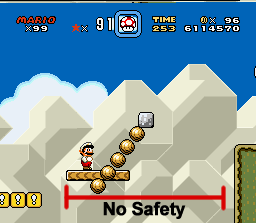
This isn’t a typical expansion challenge, but it is true to the spirit of the type—there is a gradual quantitative increase in the difficulty of the challenges. It’s just unusual in that the quantitative change is in the training-wheels—the penalty increases to 2. That’s the only real progression in the level. Challenges like these aren’t really increases in complexity, just different versions the same thing.

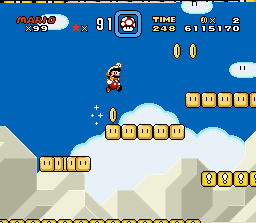
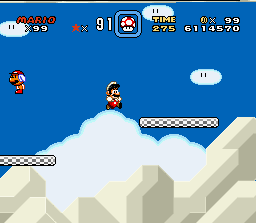
These could be called mutations, although they are serving more of an educational “you can do it” purpose than they will later in the game.
DONUT PLAINS 3
Before we dive into the individual details of DP3, it’s worth mentioning that this level, just like Yoshi’s Island 3, focuses on the skill of waiting. Even the most novice players know how to wait. This is an elegant way of acclimating new players to a tricky skill.
Donut Plains 3 introduces most of the types of moving platforms and pertinent challenges that will appear for the rest of the game—although most of the challenges appear in fairly easy forms to start. The first change from Yoshi’s Island 3 that the player will notice is the presence of the rotating platform. Like most moving targets, the rotating platform has a moderately small target width that is constantly moving; this presents a challenge in which the player has a small window of time before the platform he’s targeting goes out of reach. This is the standard challenge of the level: a rotating platform which, when timed properly, allows Mario to walk off onto the next platform instead of jumping.
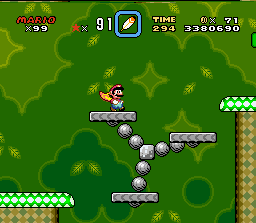
As you can see here, the jump to this platform goes from delta-height-0/d-distance-0 to delta-height 4/d-distance-3 in just a couple of seconds. Neither of these is a very hard jump, but the second position is, relatively speaking, a lot harder than the first. Thus, although the challenge is easy when attempted the right way, it’s still a challenge the player can fail and lose a life on. Note that the reason that these rotating platforms have three arms is so that if a player misses their window of opportunity to jump easily, all they have to do is wait for the next arm to come around—it won’t be long. Later in the theme there will only be one arm on these platforms which makes nailing the timing more important.
Donut Plains 3 also introduces another moving target: the tracked platform. Tracked platforms are another form of moving target, named for the visible tracks that they ride along. These platforms come in two distinct types: the cycling tracked platform and the linear tracked platform.
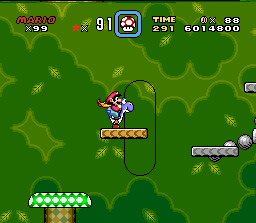
The cycling tracked platform is the one that appears first in this level: on the left, above we see a platform on a looped track that goes around in endless circles. There are some key differences between the tracked platform and rotating three-armed platform, but technically they’re both versions of the same standard challenge that asks the player to wait. The tracked platform lacks three arms, and so the waiting period for a timed jump might be greater. By itself the rotating tracked platform would be a mutation, since it’s only qualitatively different from the three-armed platform. But since this challenge connects directly to the three-armed platform, it’s an evolution that combines two qualitatively different things into one task.
The important part of this level is the three challenges that come in the middle. The first and simplest is an expansion challenge which increases the d-distance between platforms, making the player perform some real jumps. After this, we see two evolutions that diverge from challenge 2.
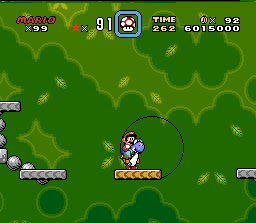
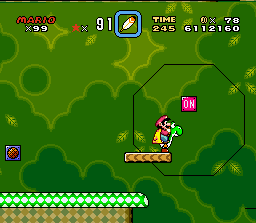
Notice that we're not straying to far from the original idea; only a few variables change whether they're quantitative or qualitative. The biggest change is in the introduction of the toggle switch. This is an inversion of the first evolution, in which the ground is moving and the target is stationary—although it requires the same timing jump skill.
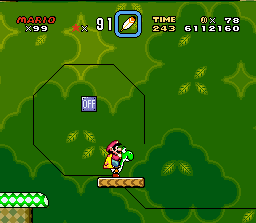
Next the level adds periodic enemies. This is another simple evolution upon challenge 2, in which the designers simply add one new element—the Fuzzy. This is the most common crossover for the moving targets theme, in which an enemy with a small period is placed in the way of a moving platform.
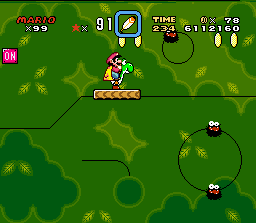
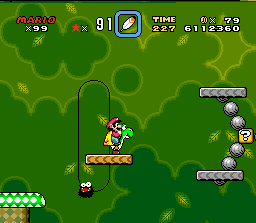
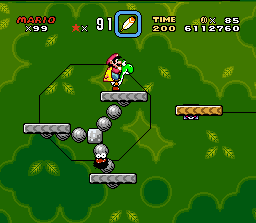
In the next challenge (middle, below) the Fuzzy shares a track with a platform, essentially modifying challenge 2 again. This time though, the challenge also includes the linear track from challenge immediately previous, with no break in between. Thus, the challenge is essentially A+B, both evolving and expanding from those two challenges. The final challenge (pictured on the right) is actually a step down from this, as is common. The hardest challenge in a level is often not its final challenge. This challenge simply evolves challenge two, with smaller d-distances between the three-armed platform and the linear track.
It seems like a simple level, and it certainly isn’t very challenging, but the designers are actually doing quite a lot in Donut Plains 3. This level has done very well in laying the ground work for timing jumps, which is good, because there is a spot-check coming for the timing jump skill in the next castle.
MORTON'S CASTLE
The second castle is, in a sense, the last stand of the “waiting game” that the player has had to work through so far. Although the timing jump remains the central skill throughout the rest of the theme, levels after this castle will progressively reduce Mario’s ability to wait. To segue into this, this castle does a couple of very interesting things, on a broad scale, which we’ll address before we dissect the particulars. First, it’s worth noting that the castle does not begin with the moving targets theme but rather its complement, the periodic enemies theme.
Want to read more? The rest of this section can be found in the print and eBook versions.